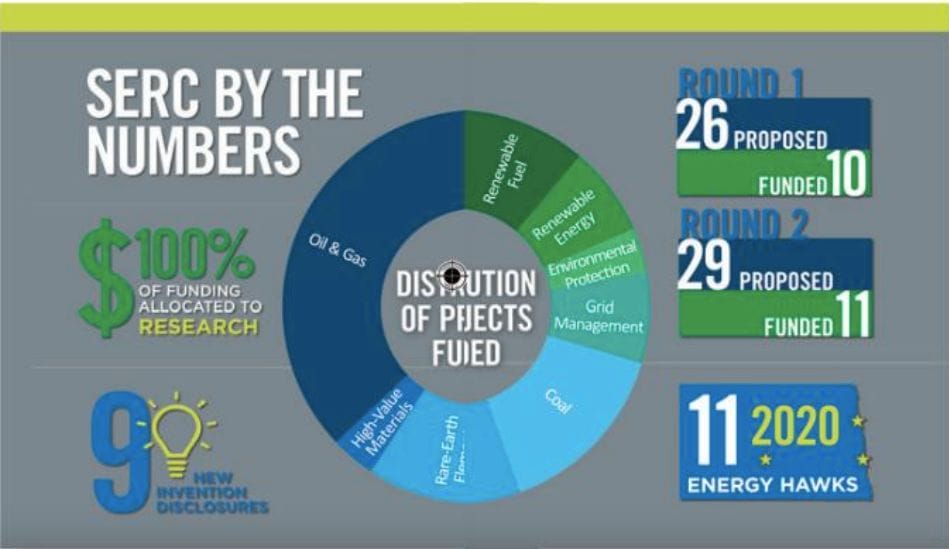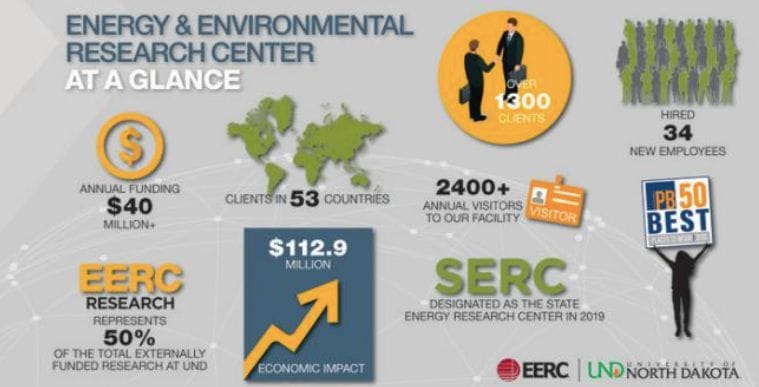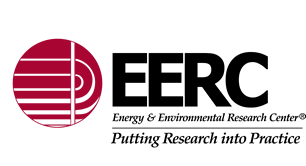Sponsored Content
In 2019, the North Dakota legislature designated the UND Energy & Environmental Research Center (EERC) as the energy research center for North Dakota. The State Energy Research Center (SERC) focuses on fundamental, exploratory topics essential to the state’s future energy industry and environmental challenges, such as value-added products from coal, alternative uses of flared gas, innovative approaches to pipeline safety, efficient lignite use, and increasing oil recovery while decreasing environmental impacts. EERC scientists and engineers are dedicated to advancing technologies that foster abundant clean energy and improve the way we use it in our modern world.
This research is producing results that could easily have billion-dollar effects on Dakota’s economy.
Tom Erickson, Director State Energy Research Center
SERC Puts North Dakotaon the Forefront of Innovation
Through SERC funding, the EERC is ensuring the state’s energy resources and products remain accessible, affordable, environmentally responsible, and clearly understood through education and outreach. This is being done through early-state research that could ultimately lead to commercial application with public and private sector partners.
Research with Results
SERC funding is awarded in a competitive process to EERC researchers to explore their ideas. To date, over 20 projects have been funded. Completed projects include research focused on electromagnetic pulses, rare-earth element recovery, and energy storage as they relate to North Dakota energy infrastructure and sustainability. This exploratory research is specifically designed to be a first step in the R&Dprocess, giving further advancement opportunities to North Dakota companies.

“On many fronts, it’s exceeded my expectations in terms of the number of new, creative ideas,” said Erickson. “It’s really exciting to see the number of concepts that we’re considering for patents and various forms of intellectual property protection after years without this type of basic research funding.”
Two promising research areas that Erickson said have significant potential for North Dakota are the extraction of rare-earth elements from coal, coal ash, and shale formations in the state and the creation of graphene from low-rank lignite coal, an abundant natural resource.
Erickson said graphene is a unique, extremely strong material in which carbon atoms are arranged in a flat plane. Currently, it’s difficult to produce but is necessary for high-value applications, such as graphene is used in electronics.
“There are reasons why North Dakota lignite and the chemistry of a lignite coal provide some advantages to producing graphene,” Erickson explained. “We think these properties of coal give it a leg up, and we see it as a great future opportunity,even though we’re in the very early stages.”
In addition to funding exploratory research, SERC provides access to EERC expertise to the state through projects chosen or requested by the North Dakota Industrial Commission and through an education and outreach component.
SERC Education and Outreach: E-Portal
The North Dakota E-Portal website was created through collaboration with educational institutions in North Dakota and with the support of SERC funding. E-Portal brings together information and resources on North Dakota energy-such as-documentaries, fact sheets, and videos- for public and educational use. The website’s goal is to provide resources to create knowledgeable stakeholders on North Dakota energy-related topics. E-Portal was recently launched and will continue to add resources. All information included on the site is objective and fact-based and is organized by topic and intended audience.
“We are working with institutions throughout the state to provide a single-source location for energy information. Nine institutions have agreed to participate and provide resources for public use,” said Erickson.
SERC Education & Outreach: Energy Hawks
Energy Hawks is a premier research opportunity for university students to better understand North Dakota’s current energy landscape and focus that understanding on future energy challenges and opportunities.
Established in 2018, the UND Energy Hawks is a group of graduate and undergraduate students from a wide range of disciplines focused on adding value to North Dakota’s energy industry through a broad range of concepts. These students study the opportunities and challenges of the energy industry and develop initiatives for further research and consideration. Traditionall, the program has included a trip around the state to experience our state’s energy landscape firsthand. This summer’s program will all be carried out remotely because of the COVID-19 pandemic. The 20202 Energy Hawks include nine UND students, one NDSU students, and one Bismarck College student.
Critical Challenges. Practical Solutions.
The Energy & Environmental Research Center at the University of North Dakota (EERC) is recognized as one of the world’s leading research organizations to develop technologies for cleaner, more efficient energy production and use. We accomplish this through our people, our partnerships, and our priorities.

Our People
Our people are our greatest asset. The EERC team of over 200 is sought after worldwide to solve energy and environmental challenges in innovative ways. Our multidisciplinary team gives us the ability to approach a challenge from all angles. Quality, market-driven science and engineering technologies come from engaged and motivated employees. We encourage lifelong learning and professional development. Our diverse workforce has interests that lie not only in the work they do at the EERC, but in the community as well.

University of North Dakota students as well as students from across the globe are integral to EERC activities. They work on real-world projects and contribute to real-world solutions. We provide work experience for students that allows them to explore career options, discover strengths, and see how academic learning applies to our day-to-day activities. Many of our longtime employees started at the EERC as students!
Our Partnerships
We work with our clients in partnership to develop, refine, demonstrate, and commercialize marketable products that provide practical solutions to real-world challenges. With access to a variety of field sites, extensive analytical and testing facilities, a broad range of technical expertise, and a breadth of partners, we offer customized solutions for our clients’ needs.
Our Priorities
Today’s energy and environmental needs require a total-systems approach that focuses on technical details while retaining a broad perspective. We are a driving force for innovation and new opportunities in the energy industry. EERC research supports an all-of-the- above approach to energy production:
- Coal Utilization and Emissions: Over 65 years of experience converting coal to energy and high-value products cleanly and efficiently.
- Carbon Management: Global leader in the area of CO2 capture, utilization, reduction, and storage. Experienced resource for industry and government in fossil fuels and biomass.
- Oil & Gas: Proven approaches to clean and efficient exploration and development of oil and gas.
- Alternative Fuels and Renewables: Trailblazing research in biomass, jet fuel, wind energy, hydrogen technology, and green diesel.
- Water Management: Expertise in balancing the demands of water and energy for our growing society.
Our Featured Projects
proposals from government and industry, competing for funding with other government and private research entities. We conduct many joint venture and consortium research projects that enable public- private partnerships:
- Plains CO2 Reduction (PCOR) Partnership Initiative – Established in 2003, the PCOR Partnership Initiative laid the groundwork for permanent, safe, and practical underground storage of carbon dioxide from industrial facilities.

- Intelligent Pipeline Integrity Program (iPIPE) – iPIPE is a consortium whose focus is to advance emerging technologies that prevent and detect leaks in pipelines.
- North Dakota CarbonSAFE – This project assesses the feasibility of commercial-scale geologic storage of carbon dioxide to manage CO2 emissions captured from coal-based energy facilities.
- Bakken Production Optimization Program (BPOP) – BPOP’s purpose is to improve Bakken system oil recovery while reducing its environmental footprint.
- CO2 Storage from Ethanol – The EERC is working with Red Trail Energy on the feasibility of carbon capture, utilization, and storage (CCUS) as a way to reduce the CO2 emissions associated with ethanol production
- Brine Extraction and Storage Tests (BEST) – As part of a public-private collaboration, the EERC constructed a facility in western North Dakota to pilot-test high-TDS (total dissolved solids) water treatment technologies.
- Rare-Earth Elements (REEs) – We are researching domestic sources of REEs which have special properties that make them useful in high-technology products such as smart phones. The United States currently imports nearly 100% of its REEs from China.
- Water Minimization – The EERC is working with the U.S. Department of Defense on a dry-cooling technology that reduces the amount of water needed in cooling systems for large office buildings.








